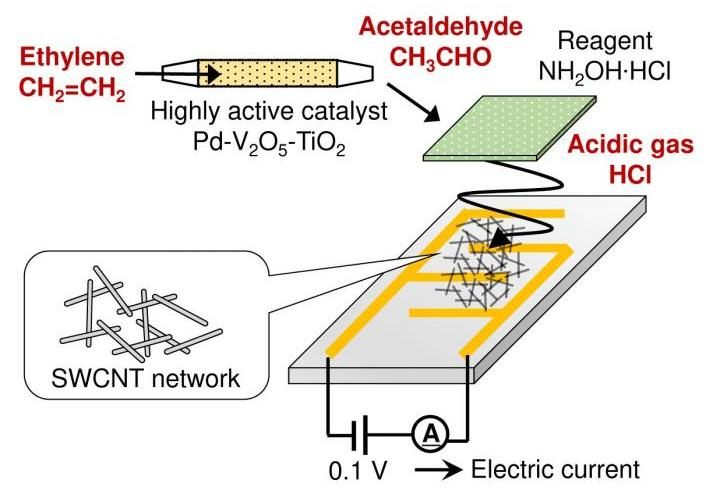Jun 30 2020
A small sensor designed by the National Institute for Materials Science (NIMS) and the National Institute of Advanced Industrial Science and Technology (AIST) can constantly track the plant hormone, ethylene.
 A small, highly sensitive sensor capable of detecting ethylene with great selectivity. Image Credit: NIMS.
A small, highly sensitive sensor capable of detecting ethylene with great selectivity. Image Credit: NIMS.
While ethylene gas is known to promote ripening in vegetables and fruits, too much exposure can spoil the produce.
The novel, small sensor can be used for tracking vegetables and fruits by constantly detecting ethylene gas. This preserves freshness at the time of storage and transportation, and also helps decrease food waste.
Ethylene is essentially a gaseous molecule discharged by vegetables and fruits as a phytohormone that promotes ripening. Fresh produce can be ripened in an artificial manner in postharvest storage by adding ethylene to a storage facility.
Constant tracking of ethylene levels in such facilities may enable researchers to estimate the ripening progression of stored produce more precisely, allowing ideal storage schedule and transportation.
Thanks to this potential advantage, there has been a huge demand for the development of low-cost, small ethylene sensors from the food and agricultural sectors. Small sensors that have the ability to detect ethylene are available in the market, but a majority of them function only at high temperatures (200 °C~300 °C).
Moreover, the commercially available sensors that use semiconductors as sensing materials are capable of detecting other gaseous molecules (for example, methane and alcohol) simultaneously because of its highly active surface. Thus, such existing sensors do not have selective sensitivity to ethylene.
In this latest research project, the scientists have designed a small yet highly responsive sensor that can detect ethylene with excellent selectivity. The new sensor comprises three components: a single-walled carbon nanotube (SWCNT) electrode that is highly sensitive to acidic gas, a reagent that reacts with acetaldehyde to discharge acidic gas, and a highly active catalyst that optionally transforms ethylene into acetaldehyde.
A highly active catalyst such as this can repeatedly transform ethylene into acetaldehyde as analyte-air travels through it. Besides, the catalyst can function at near room temperature (40 °C), rendering the small sensor energy efficient.
The acidic gas generated by the reaction between the reagent and the acetaldehyde firmly extracts electrons from the SWCNT semiconductor, altering the electrical resistance of the semiconductor.
Such mechanisms and characteristics allow the sensor to sensitively and selectively identify ethylene even at very low concentrations (0.1 ppm) by tracking alterations in electrical resistance.
It is believed that the sensor can efficiently track the concentrations of ethylene for several types of fresh produce in storage. For instance, the ethylene levels that support ripening in kiwifruit and bananas are around 10 and 500 ppm, respectively, which is well within the useful sensitivity range of the sensor.
This economical, small, energy-efficient, ethylene sensor has been developed to be used with networking systems and big data integration, and may thus act as an essential tool in putting Japan’s super-smart society vision (the Society 5.0 initiative) into practice in the food and agricultural sectors.
The research team is developing several kinds of highly active catalysts to create tiny sensors that can also detect gaseous molecules, in addition to ethylene.
The study was conducted by a research team under the guidance of Shinsuke Ishihara (Principal Researcher, International Center for Materials Nanoarchitectonics, NIMS), Dachao Hong (Researcher, AIST Interdisciplinary Research Center for Catalytic Chemistry), and also other scientists from the AIST Nanomaterials Research Institute and the Indian Institute of Technology Mandi.
Journal Reference:
Ishihara, S., et al. (2020) Cascade Reaction-Based Chemiresistive Array for Ethylene Sensing. ACS Sensors. doi.org/10.1021/acssensors.0c00194.